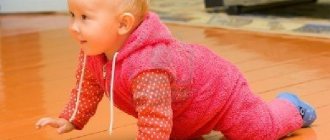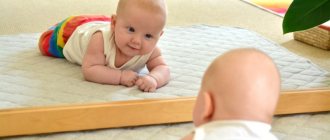When does a baby start crawling? When his body is ready for it. This means that the muscles of the back, neck, legs and arms have become stronger, the child holds his head and back well in an upright position, and can roll over from his back to his stomach and back. Often children begin to crawl first on their bellies, and then on all fours. Sometimes a child first learns to sit on his own and then crawl, sometimes vice versa. Some children begin to learn to crawl at 4 months, some at 8-9 months, but most begin to move independently at 6-7 months.
Why is it so important for a child to learn to crawl?
Crawling is a necessary stage in a child's development. The development of a baby in the first year of life is called psychomotor
, that is, the development of motor skills is inseparable from the development of intelligence, psyche, and speech skills. The child develops sequentially, having mastered one stage, moves on to the next. By overstepping or skipping any of the stages, we leave a gap in the child’s development that cannot be filled with other skills.
Crawling prepares the baby's hands for manipulating small objects, and the back muscles for the stress of walking upright. During crawling, the connection between the right and left hemispheres of the brain is strengthened - this affects the development of intelligence and speech
. Crawling is a universal exercise that strengthens all the muscles of the body. In addition, free crawling gives the baby the first experience of independent movement in space, strengthens his self-confidence, feeding his curiosity and perseverance in achieving goals.
Often, as a result of crawling, minor impairments go away or are compensated for.
tone, asymmetry, torticollis and other similar problems.
features of brain development
become visible (insufficient communication between certain parts of the brain) - when a child persistently, for more than 2-3 weeks, crawls in a certain specific way: he drags or bends one arm or leg, crawls only backwards.
If at this moment you help the child learn to crawl correctly
, then this will have a beneficial effect on brain development, possibly compensating for developmental features.
How to teach a child to crawl?
The most important thing is to provide the child with the opportunity to learn to crawl. To do this, he needs space, time and your caring participation. This is easy to do - place the baby on the floor
!
Yes, yes, on the floor. Learning to crawl on a large bed or sofa will not work, it’s too soft, but it’s easy for an agile baby to fall from there, just quickly push off with your feet a couple of times. There is nowhere to fall on the floor
, but a new, unknown and alluring world opens up around you.
You can put your baby on the floor from 2-3 months
when the baby learns to roll over well.
Make it a rule - when removing a child from your arms or taking him out of a sling, put him on the floor
, and not in a crib, changing pad or in a chaise longue.
First, place him on a soft rug or mat , and at the same time combine this with “nappy-free” time.
Modern lungs. Elastic and pleasant to the touch crawling mats are suitable for children from the first months of life. Crawling rugs, consisting of several parts fastened together like a puzzle, can be easily assembled into one large carpet or long runner, depending on the size and shape of the room. It is more convenient when the tiles of such a puzzle mat are large (for example, 33cm x 33cm) and without small parts inside. The larger the parts of the rug, the fewer joints the rug has and the more uniform the surface, which means it’s easier to maintain cleanliness. However, large tiles for a rug are more difficult to buy, are inconvenient to transport and take up more space.
Choose a moment when your baby is full, happy and active. Place him on his stomach, next to him, at arm's length - a new bright toy
(or a thing that he has noticed for a long time and was reaching for, for example, a bright large salad spoon, an unnecessary magazine or something similar). Rejoice with your baby at his catch when he can reach it. After a couple of days, the distance to the new “bait” can be increased.
Crawling on your stomach, on all fours or...
All children are different and develop at their own pace. Some people start crawling on their belly and then quickly learn to get on all fours and soon become a master of cross crawling.
.
Some people, having mastered crawling on their bellies, continue to crawl. We will describe the general sequence of skill development
, and the timing of training depends on the individual child and his family.
(For more information about the stages of child development, read the book by
Beverly Stokes “Amazing Babies. The necessary movement of a child in the first year of life”)
A newborn baby lying on his stomach learns to lift and hold his head. Then, over a couple of months, he learns to raise his upper body higher, leaning on his hands. When a baby is able to rise almost to his stomach from a position lying on his stomach with emphasis on his hands, he discovers that he can move backwards, pushing off with his hands
. At this point, it is important that the small fists begin to open without pinching the thumb inside.
Crawling backwards on your stomach
An attractive activity compared to simply lying still.
A child can crawl like this for a week or two. After some time, he will begin to push off with his feet, gradually getting up on all fours. During this period, the child can stand for quite a long time, swaying in one place
and trying to coordinate the efforts of the arms pushing back with the legs moving the body forward.
Often such attempts end with a rapid “forehead hitting the floor” and loud crying. Stay calm, it’s safe; after hitting the bumps, the child will quickly learn to be more careful
and calculate his strength better.
Encourage your baby, he is already halfway to full cross-crawling on all fours.
What methods of crawling are there, their stages
A child can choose a convenient method of transportation for himself and use it contrary to the ideas of adults. Under no circumstances should you retrain your child.
Most children find it comfortable to crawl this way:
- spasmodically. The baby gets on all fours and rocks back and forth, and then suddenly jumps forward. This is an interesting method that many children use, but it is far from safe;
- in Plastun style. Standing on all fours, he crawls forward. At the same time, his body touches the floor.
- in reverse. Some children crawl backwards, which puzzles their parents. Neurologists even prescribe treatment for such babies, although official medical science does not consider this feature a deviation;
- rolling. This can hardly be called crawling; most likely, the cause is laziness and the desire to get an interesting item. This method is not the most correct, so the parents of such a child should intensively engage in gymnastics and massage with him;
- On knees. This is how 9-8 month old babies crawl. The baby's back is straight, and the hands set the pace of movement. The limbs move synchronously.
Stage “I’m an airplane” or how to lift your stomach off the floor
Before learning to get on all fours, children go through the “airplane” stage. The child lies on his stomach and simultaneously lifts both his arms and legs off the floor, slightly rocking himself. It is impossible to budge in this way, so the baby screams loudly
and requires attention to your experiences.
You can help your young tester by placing a bolster, a soft cloth ball of the appropriate size, or a folded blanket under his stomach. The roller may be small at first
, place it under the baby's chest. Then try a larger roller, you can slightly rock the child back and forth, showing him that this way he can move on all fours. Instead of a bolster, your leg will do if you sit on the floor with your child.
A professional massage will also be useful at this time.
, which will help consolidate new skills and give impetus to the comprehension of new motor capabilities. You can do some exercises with your child yourself.
(More about exercises and baby massage here).
Baby crawling exercises
If a child at 6 months has mastered crawling “with his stomach”, but does not begin to crawl for real, this means that he does not know how to stand with his arms straightened, does not understand how to overcome the force of gravity in order to break away from the surface, or how to get on all fours . Parents can help him by performing various crawling exercises with the baby.
Let's deal with the hands. You can teach your baby to straighten his arms by hanging a flashy toy above his head while in the tummy position. The baby will be forced to stretch out his arms to reach it. Moreover, he will have to lean on one handle to take the toy with the other
Therefore, it is important that he uses each hand in turn. Another exercise is the “wheelbarrow” (many parents remember this from their childhood), it will teach the child to move with the help of straight arms. You need to support the baby by the hips or under the chest in a tummy position, straighten the arms and start pushing him forward
The baby will have to rearrange the handles. You can put an attractive “prey” in front of him in the form of a toy or treat. We use the vestibular apparatus. Balance is important for all mobility skills. Crawling is the first one. Therefore, it’s time to start active training. You need to lay the baby on his tummy on a cushion of blanket or towel. The arms remain free, so the baby should be encouraged to reach for the toys lying in front of him. Gently lifting the baby with the help of a wide towel, which is used to pick up the baby under the tummy, will help develop balance, while showing that gravity can be overcome. It should reach the floor, but not feel its weight. We get on all fours. You will need a large bolster made of a blanket - such that the baby, leaning his tummy on it, can stand with his straight arms and bent legs. Mastering the knees. If a child stands up straightening his legs, he needs to be taught to bend them at the knees. Supporting the baby under the chest, you need to lower him with bent legs onto a soft support (blanket, sofa) and slowly pull the baby forward. The baby will begin to move his bent legs. You can stimulate him to do this in another way. For example, place the handles on the blanket and lightly pull on it. Or place another object instead of a blanket that will slide along the floor (a book, a box). We teach to crawl. Dad's help is needed here. Let him move the legs of the baby standing on all fours, and let the mother move the arms. It’s good if the baby understands that he needs to crawl for something specific (his favorite toy). Example. Having taught your baby to stand on all fours, you can show him a clear example of crawling. The role of the “model” can be the mother or older children, if any.
Do you want to crawl? Ask me how!
If, despite your best efforts, your baby shows no interest in crawling, try setting a good example. The most effective thing is to invite a child who crawls well to visit.
about the same age. Have fun crawling with the whole family; this exercise will not only surprise and entertain the baby, but will also help tired mom and dad relax their “backs.”
Use a crawl track
, a low children's slide or just a wide board (cabinet door).
Make a slight tilt so that every movement of the baby helps move forward. Cheer and celebrate every success. Let the baby first overcome ten centimeters, the main thing is that he understands that he can. Remember about “baits”, show and praise an inaccessible target
, but do not give it to the child, even if he screams and is indignant. But what a joy it is to reach out and finally get the desired toy!
Baby on the floor? Right there...
Cold ? If you do not live in a hut with a dirt floor, or do not walk on bare concrete at home, then the child will be warm enough on the floor. At first, when the baby learns to move, use a mat that is pleasant to the touch . It is important that the crawling mat does not slip, is sufficiently elastic and easy to wash. A wool blanket is warm and natural, but as a crawling mat, it quickly becomes disorganized under the pressure of an energetic novice crawler. You can also use tourist foam, but such a crawling mat is too narrow, so one foam is not enough; it is better to use two or three. Experienced parents advise using rugs no smaller than a square meter in size, and preferably one and a half or two, if it fits in the room.
Soon the baby will learn to crawl out of a warm place. If it seems to you that it is still cold on the floor, for greater comfort for the child and your peace of mind, put on a woolen bodysuit ( thermal underwear ) or merino wool pants . The wool of Merino sheep is warm, soft and not itchy, making it suitable for babies. Woolen pants and a bodysuit are the best equipment for a baby starting to crawl. Such clothes are warm enough to prevent your baby from getting too cold, and thin and soft enough not to interfere with his movement. The less clothing a child wears, the easier it is to learn to crawl. Knit woolen pants from merino yarn yourself if you know how, or buy ready-made ones from natural swaddling systems, etc.
Dirty ? Make cleaning easier by temporarily removing expensive carpeting. (Remember that potty training time will soon come). You can quickly wipe down a wooden or laminate floor. In the hallway and other quickly dirty places, rugs that can be washed in a washing machine will help out. If you don’t have enough time for daily cleaning, buy a robot vacuum cleaner that can also handle carpet.
If, starting from 2-3 months of the child’s life, the parents “ go to live on the floor”
" together with the child, this will help to gradually, even before active crawling, resolve issues with dust, drafts, etc. This will help protect the child from injury (there is nowhere on the floor to fall).
Microbes ? For normal development of immunity, a child needs to live in a real, not a sterile world. It is clear that licking outdoor shoes is not good for health, but encountering
“ household ” microbes is inevitable
. You should not wash the floor with aggressive chemicals, they are even less beneficial to health. For disinfection during cleaning, you can use aromatic oils that have antimicrobial properties (tea tree oil, juniper oil, etc.).
Cat (dog, etc.) ? Place the food bowl higher up, make access to the litter tray as difficult as possible for the child, and the bedding should be cleaned and washed more often. Take your animal to the veterinarian regularly and conduct antiparasitic treatment courses. Pay maximum
attention to cleanliness and relax
.
Even if you restrict the child from crawling now, later contact with the animal cannot be avoided. So reconcile yourself in advance and let the child sit on the floor
.
Conditions for skill development
Sometimes parents underestimate the importance of the developmental environment, relying solely on the internal strengths of the child’s body. However, adults can still create some conditions for developing the ability to crawl.
Space to move
The more free space you give your baby, the sooner he will start crawling. You should not rely on the playpen; it is better to clear the floor for the baby. Of course, before putting children on the carpet, remove all unsafe objects from the room.
Surface
The ideal option is a hard surface, such as a carpet or a hard blanket. Some parents purchase a specialized crawling mat. You should not place your baby on slippery linoleum or uncomfortable parquet floors. Wide double beds are also not suitable as they are too soft.
Obstacles
They are required after the child learns the simplest and even primitive manner of movement - on his tummy. By placing various barriers and obstacles along the baby’s path, you will “force” the baby to raise his body in order to move forward.
Interest
To encourage your baby to be physically active, try to interest him in a new or favorite toy; a kind of “bait” in the form of a pet is also suitable. That is, it is necessary to create many objects for research around the child.
Roller as a trainer
You will need it to teach your child to crawl on all fours. Such exercises will be useful for those kids who prefer to move on their bellies. Place your baby's tummy on the cushion and rock him back and forth. These movements will force the baby to rearrange his arms and push him to a real cross crawl.
Shall we crawl? Let's crawl!
Before the baby has learned to fully crawl on all fours, parents need to
literally crawl the entire house on your knees.
Firstly, you will set a wonderful example for your child, and secondly, you will be able to inspect your home in order to detect in advance all
objects that are dangerous for the baby, look into secluded corners and raise higher things that are valuable and dear to your heart.
Make your home as safe as possible
for your child.
Hide the trash can and put away all household chemicals, washing powders, fertilizers, pet food, pots of indoor plants, etc. as high and far as possible. Pay attention to low-lying electrical cords (a child can taste them) and sockets, overhanging edges of tablecloths and other dangerous or small objects. Please note that the child will definitely want to taste it.
, whatever he finds.
Create a small corner in every room
with interesting and safe things for the baby. It could be a shelf at the bottom of a closet or a small box, but such a beacon should be made in every room of the apartment, even in the hallway or bathroom, if it is not locked. Having reached a new place, the child will be carried away by the “local attractions”, and, if lucky, will not have time to climb somewhere else without your supervision.
Remember that from the beginning of crawling to 2.5 years is the period of strengthening the love of order.
.
It's time for parents to get acquainted with the M. Montessori system
in order to introduce life-friendly principles into home use.
The most attractive toys for a beginner crawler
- This is
a small rag ball with a ringer inside
and a tumbler. And also all the small noisy objects that are convenient to grab with a small hand and easily throw, so that they fly and roll, and then catch up with you. During the period when the baby is just beginning to move and sways and rolls more in one place, be attentive to the toys that are on the floor with the child. Choose safe, soft toys that won't hurt your child if they bump into or fall on them.
Safety precautions during training
Before you teach a child to crawl, you need to worry about his safety. To do this, go as low as possible and look at the room with baby eyes
What is important to consider for a comfortable crawling journey?
1. Correct temperature
The floor should not be too cool or too hot. And, of course, no drafts. If it’s still cold in the apartment, dress your child in warm, but comfortable clothes for movement.
2. Dangerous items
Particular dangers for the little explorer are corners, cabinet doors, and tablecloths on tables. Buy covers for furniture corners, block the doors, remove the tablecloth, which the baby can knock over along with heavy or sharp objects.
3.Height
This dangerous factor disappears if the baby moves on the carpet. Crawling on a sofa or bed requires parents to be near the baby. It’s good if a child falls and ends up with a bump and crying. What if a serious injury occurs or a fear of heights develops for life?
4. Electricity
We hide the wiring and cords, and put plugs on the sockets. Carefully scan the entire house for dangerous electrical appliances near your baby. They need to be raised or even hidden until better times.
6. Pets
Speaking of pets. They should be regularly examined by a veterinarian for parasites and worms. Kids usually get along well with cats and dogs, but aggressive animals should be kept away from the crawling toddler. Of course, ideally, the child himself should understand how to crawl. However, if your baby is unable to crawl, you can help him. Be patient and remember that even if you didn’t end up with a crawling baby, you prepared his body for the next stage - upright walking, by strengthening the muscles and developing the vestibular apparatus.
Walkers, jumpers and other “utilities”
According to osteopathic doctors, learning to stand and walk earlier (before crawling) has a bad effect on the development of the child’s entire musculoskeletal system. For the normal formation of the musculoskeletal framework necessary to begin walking independently, the child needs to crawl for two to three months
.
After the child begins to crawl, he learns to sit up on his own, kneel down, and then stand at a support. The baby should go through all these stages consistently and independently; there is no need to force events
and teach the child to walk prematurely. You should not lead a child who has not yet learned to crawl or stand on his own without support by both hands.
Walkers and jumpers
– these are items that should not appear in the home of caring parents.
If the use of a playpen is simply a restriction of a child’s freedom, a kind of prison
that prevents the child from developing physically, mentally and intellectually, then walkers and jumpers, due to the early vertical load, cause very noticeable harm to fragile muscles and ligaments.
The vertical position, together with the weight of the child, creates an excessive load on the intervertebral discs
, for which they are not yet ready.
They become crushed (compressed), which in the future threatens problems with the spine at any age. The developing foot also experiences greater premature stress in walkers. You can understand the desire of tired parents to take a little break and go about their business while the child entertains himself by jumping. But having learned to crawl, the child will explore the world around him
, developing himself and strengthening his health.
Children accustomed to walkers and jumpers begin to crawl much later
, often skipping this important stage of their development altogether. Is half an hour of your peace of mind worth it?
No crawling threat
Crawling is not a necessary stage of development, like, for example, holding your head. But it is incredibly useful, it is better not to miss it. It is this action that strengthens the muscles around the spine like nothing else.
If the baby quickly gets to his feet, not wanting to crawl, you cannot hold him by force. Then you need to start an additional course of professional massage, go to the pool with your toddler, and do infant gymnastics more often. The best option would be to start helping him crawl, showing an example before he even tries to roll over onto his side, especially before he tries to sit down or stand on his feet.
Crawled, sat down, stood up - the ideal development of a baby
Summarizing all of the above, it can be noted that you should not give up crawling on your own. Parents must understand that they are responsible for the health of their baby. First of all, do not what is convenient for them, but what is best for a small defenseless person. Doctors will help them with this, and they should not avoid visiting them.
If the child does not crawl...
Sometimes you can hear parents proudly say: “ But mine didn’t crawl, it just walked !” . They probably don’t know that if a child does not crawl at the right time, this may result in incorrect posture, back pain and curvature of the spine in the future. Such problems often arise against the background of poor heredity
(the child’s parents and their parents had some problems with the musculoskeletal system), heavy loads, for example, at school, and during the child’s growth spurts.
increased loads are contraindicated for modern children who did not crawl but immediately walked.
associated with early intensive sports (participation in competitions, professional sports).
Roller skating and skateboarding should be excluded. While studying at school, it is imperative to engage in physical therapy
, swimming, and be regularly observed by orthopedic doctors in order to promptly identify postural disorders or other spinal diseases (for example, premature aging of intervertebral discs).
All these problems are easier to avoid
than to cure. If your baby is not crawling yet, but is already starting to stand up, you should pay special attention to this. Your timely efforts will help the child learn to crawl, keeping the spine healthy and making its development more harmonious.
Organizing a safe crawl space
Every mother should get down on all fours in her apartment and look around with the eyes of her child. This will make clear all the dangerous places, obstacles and small objects that are lying on the floor and may end up in the baby’s mouth.
There should be fastenings on the furniture so that the baby cannot pull on the easily opened drawer and pour its contents onto his head. Also required are locks for doors, windows, toilet rims, as well as many other devices that can protect the child’s learning process.
Parents should understand that if the baby crawls and accidentally hits himself, he may get scared and stop striving to learn a new skill.
All sockets must have special plugs, and they must be difficult to get out of there. Under no circumstances should wires be within reach of a child. It is also better to hide all breakable, sharp and fragile objects, as well as chemical household products for cleaning and personal hygiene. All this should be upstairs, out of reach of the baby.
The child will crawl exactly when he hears the call of nature. There is no need to get ahead of or speed up the process. It is enough just to support the baby and give him freedom of action. Parental support and praise is very important for children. So they believe in themselves and try even harder. Komarovsky is right in this situation - the child should not live up to anyone’s expectations or written deadlines. He develops individually, and his parents should help him with this.
Read further:
When does a newborn baby begin to crawl and sit?
The main rules in the process of getting used to the potty
Teaching your child to use the potty independently
Not crawled yet. When should you start worrying?
All children develop at their own pace. No one knows your baby better than you. In order not to miss conditions that require correction, regularly show your child to medical specialists you trust
. Pay attention yourself and tell your pediatrician about the characteristics and pace of development of the child in accordance with his age.
If a healthy child at 8 months
is not yet making any attempts to crawl on his own, it’s time to pay special attention to this.
Consult a pediatrician, show your child to an orthopedist, get a massage, visit an osteopath. Make sure your baby is healthy and has every opportunity to start crawling
: loose clothing, plenty of floor time, and your support.
You can use the track for crawling. And the time spent in the playpen or crib should be reduced as much as possible. If the baby has already learned to stand on a support, but hardly crawls, distract him and encourage him in every possible way to try
to move on all fours.
What gives a child the skill of sitting?
To appreciate the importance of this process, you need to understand the following. A child who spends most of his time lying down suddenly realizes that an unknown world extends around him.
At the same time, the baby’s hands, when he is sitting, allow him to take the toy, feel it and put it in his mouth. He can easily play alone when he is in this position. Parents will feel a real sense of relief when their baby can entertain himself for some time.
Sitting prepares the child's back for walking. This is its benefit and harm, because the standing position increases the load on the spine. Sitting, on the contrary, strengthens the muscles, making them ready for the first steps.
That's why it's so important not to rush things. And it is best to prepare the spine for increasing loads, i.e. crawling. After all, this is one of the most important skills for a child.
How to teach a baby to crawl at 8 months? Every child is different, so not everyone starts performing these movements at the same time. Further in the article the features of this process will be discussed.
Now you won't catch up!
When a baby begins to crawl, a new era begins
.
Now your baby is no longer that cute toddler waving his arms and legs in his crib or sitting importantly in his mother’s arms. Parents realize that another person now lives next to them, with his own character
and interests, speed and love of freedom.
Share the joy of a pioneer with your child and enjoy these wonderful moments. After all, very soon your baby will learn to walk, run, climb and talk. Prepare for this time together, don't rush it, let it creep !











